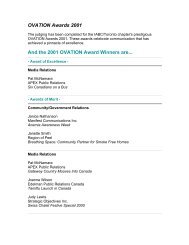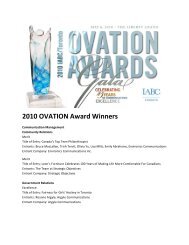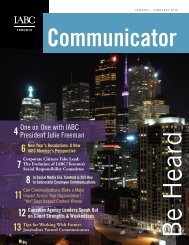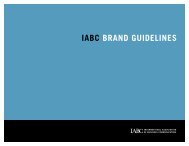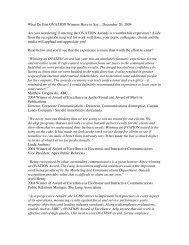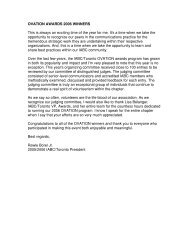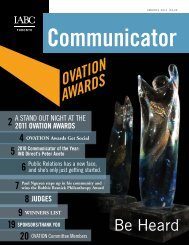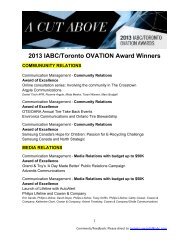Table of Contents 6 2012 OVATION Awards Winning Entries
6. 2012 OVATION Awards Winning Entries - IABC/Toronto
6. 2012 OVATION Awards Winning Entries - IABC/Toronto
- No tags were found...
Create successful ePaper yourself
Turn your PDF publications into a flip-book with our unique Google optimized e-Paper software.
and Mail following the amalgamation announcement the key to a successful amalgamation is<br />
communication as “a merger brings change management skills to the fore. There are all sorts <strong>of</strong><br />
uncertainties and questions, and even if you don’t have the answers, you have to determine who are the<br />
stakeholders are what they need to know. Because if we don’t tell them, they are going to make<br />
assumptions…”<br />
Using key learning garnered from the legacy merger that created Meridian in 2005, Meridian also decided<br />
to use face‐to‐face leader‐lead communications when communicating to former DCU employees. This<br />
would help build a two‐way stream <strong>of</strong> conversation and answer questions from new staff, but more<br />
importantly it would put a face to Meridian – a credit union that many <strong>of</strong> these new employees had never<br />
been exposed to.<br />
Goals and Objectives:<br />
Meridian’s corporate communications team developed a comprehensive plan that featured two main<br />
audiences and phases. The first component <strong>of</strong> the plan would focus solely on amalgamation<br />
announcement to current Meridian employees. For current Meridian employees, the communications<br />
objective was to inform them <strong>of</strong> the amalgamation, explain the benefits <strong>of</strong> amalgamation to the credit<br />
union overall, stress that no current Meridian employee would lose their job as a result <strong>of</strong> the<br />
amalgamation and explain that it was business as usual until the full conversion has taken place.<br />
The second component <strong>of</strong> the communication plan focused on the new Meridian employees (former DCU<br />
employees). Communications to this specific audience geared around educating them about Meridian and<br />
providing insight to Meridian’s culture. A successful integration <strong>of</strong> the two credit unions would be largely<br />
dependent on the pace <strong>of</strong> change for the former DCU employees and their ability to digest new<br />
information, concepts and expectations while making the “mindset shift” to Meridian. As former DCU<br />
employees will have to absorb massive amounts <strong>of</strong> information and cope with significant changes in<br />
policies, products and technologies, internal communications would play a key role in easing the change<br />
management until the full conversion <strong>of</strong> DCU into Meridian (scheduled to be completed in spring <strong>2012</strong>).<br />
A comprehensive employee communications plan was developed to support current Meridian<br />
employees and former DCU employees, also referred to as new Meridian employees. The following<br />
objectives were created:<br />
1. Following the proposed amalgamation announcement on March 1, 2011, ensure all current<br />
Meridian employees understand the benefits <strong>of</strong> the proposed amalgamation and have the tools<br />
they need to effectively answer Members questions and concerns.<br />
2. Provide Branch Managers and Assistant Branch Managers (leaders) with the right communication<br />
tools so they can effectively reinforce key messages and support their teams.<br />
3. Ensure all new Meridian employees (former DCU employees) understand and embrace Meridian’s<br />
approach to superior, personalized service and feel adequately welcomed and engaged at Meridian.<br />
Success Measurement:<br />
The success <strong>of</strong> the objectives 1 and 2 outlined above was measured through the post‐evaluation survey,<br />
where if 80 per cent or more <strong>of</strong> employees answered strongly agree/ agree to the corresponding<br />
question, it was considered successful.<br />
Success <strong>of</strong> the third objective would be measured by the annual employee survey (executed by an<br />
independent third party). In the survey, former DCU employees were asked to answer 12 questions<br />
regarding their engagement on a 5‐point scale with 1 being extremely dissatisfied and 5 being extremely<br />
satisfied. This objective would be classified as successful if the former DCU employees scored a<br />
collective employee engagement score <strong>of</strong> 4/5.



